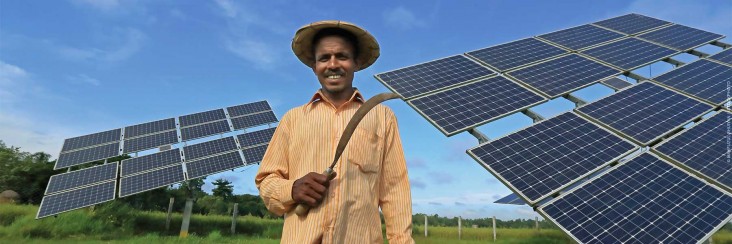Advanced Energy Systems: Grid Integration of Variable Renewable Energy and Flexibility Solutions
Focused on Bangladesh, this second webinar series introduces common best practices and emerging solutions that help countries efficiently deliver renewable energy to the grid.
USAID supports partner countries on their journey to self-reliance by helping design and implement auctions that can rapidly scale clean energy at low prices and advance national economic and clean energy goals. USAID provides support for auctions through bilateral and regional energy programs and a variety of programs managed out of Washington, D.C.
As costs of renewable energy technologies continue to fall, many countries are looking to integrate variable renewable energy as part of the generation portfolio mix to support national clean energy and economic targets. Power systems can be diverse and context-specific, and each country has unique considerations. However, there are fundamental concepts and best practices concerning power sector planning, grid integration, flexibility, and storage that can lead to successful renewable energy development. “Advanced Energy Systems: Grid Integration of Variable Renewable Energy and Flexibility Solutions,” a four-part series of capacity-building trainings, introduces these concepts and best practices.
The series of four webinars begins with Introduction to Renewable Energy in the Power System, which introduces the key concepts of renewable energy integration and reviews challenges and common myths related to grid integration. Power System Long-Term Planning for Renewable Energy Integration reviews the Bangladeshi context as well as tools and best practices for evaluating how to reach policy, reliability, and investment targets. Grid Integration Challenges and Solutions for Increasing Power System Flexibility provides an overview of grid integration studies and their applications, concepts and strategies to overcome barriers to flexibility in the generation fleet, and international lessons learned for cost-effective grid integration. Finally, Utility-Scale Energy Storage Systems reviews key considerations and provides an overview of tools to support policymakers in making techno-economic decisions about the deployment of storage as the penetration of renewables increases.
USAID hosted the Advanced Energy Systems webinars in December 2020. Coordinated through the USAID Scaling Up Renewable Energy program and the USAID Laboratory Technical Support for Clean Energy Scale Up and Investment in Bangladesh, the trainings provided the agencies of the Government of Bangladesh, as well as private sector stakeholders, with the fundamental knowledge and resources needed to make informed decisions about integrating renewable energy into the grid. Interactive polling questions and a chat room with a Bangla translator enabled participants to apply and discuss concepts learned during the training.
As a result of the trainings, participants learned how to:
- Understand key concepts and challenges of large-scale renewable energy integration;
- Identify the models and planning tools required for robust power system decision-making;
- Work with strategies that are effective in creating an enabling environment for power system flexibility to support solar and wind integration, including various ancillary services; and
- Consider approaches that support policymakers in understanding the type, size, and location of energy storage that would best benefit the Bangladeshi power system.
Advanced Energy Systems: Grid Integration of Variable Renewable Energy and Flexibility Solutions
Following is a breakdown of the topics covered in the four modules.
-
Introduction to Renewable Energy in the Power System
- Learn characteristics of renewable energy and how integration could impact the power system;
- Identify key concepts and challenges for large-scale renewable energy integration;
- Debunk common myths related to grid integration; and
- Understand the role of ancillary markets, cross-border trade, geographic diversity, and balancing area breadth.
-
Power System Long-Term Planning for Renewable Energy Integration
- Understand traditional power system planning (generation and transmission) concepts and how they change with the introduction of renewable energy;
- Understand the primary operational challenges to integrating renewable energy into the grid; and
- Review tools and models that can help support integration of renewable energy: generation and transmission capacity expansion planning, production cost, and economic optimization modeling.
-
Grid Integration Challenges and Solutions for Increasing Power System Flexibility
- Review grid integration studies and their applications;
- Identify stakeholders, data, analysis, and capacity required to conduct a study;
- Recognize conventional power plant flexibility concepts and understand cost-effective flexibility strategies;
- Learn how to overcome barriers to flexibility in the generation fleet;
- Observe how forecasting relates to power system operations; and
- Understand the flexibility supply curve framework.
-
Utility-Scale Energy Storage Systems
- Become familiar with storage fundamentals and their emerging role in supporting integration of VRE;
- Learn how storage technologies impact power system flexibility;
- Review policies, regulations, and operational practices that enable power systems to utilize different value streams provided by storage (value stacking);
- Identify tools and metrics to evaluate storage value in power system planning analysis; and
- Know how to evaluate the capacity value of storage resources for the bulk power system.
Happy woman relaxing with wind generators turbines beautiful sunset background in Khao Kho mountain, Petchabun, Thailand.
© theeraphong / Adobe Stock
Renewable energy auctions have emerged as the best practice for procuring least-cost energy. This competitive, transparent process helps countries meet their energy goals and attract private investment on their journey to self-reliance.
In today’s rapidly evolving renewable energy marketplace, it can be challenging to keep track of current best practices in renewable energy policy, innovations, and market trends. USAID developed the Renewable Energy Auction Toolkit to help international development professionals, energy ministries, utilities, policymakers, and regulators to design and successfully implement energy auctions that expand access to affordable and sustainable clean energy.
The proliferation of renewable energy resources requires comprehensive changes to power infrastructure, market design and business models. USAID, through its Scaling Up Renewable Energy (SURE) project, helps partner countries plan, procure, and integrate renewable energy. USAID’s efforts enhance global energy security; promote private sector investment through transparent, competitive procurement; and open paths to self-reliance by empowering partner countries to control their own economic and social development.



Comment
Make a general inquiry or suggest an improvement.